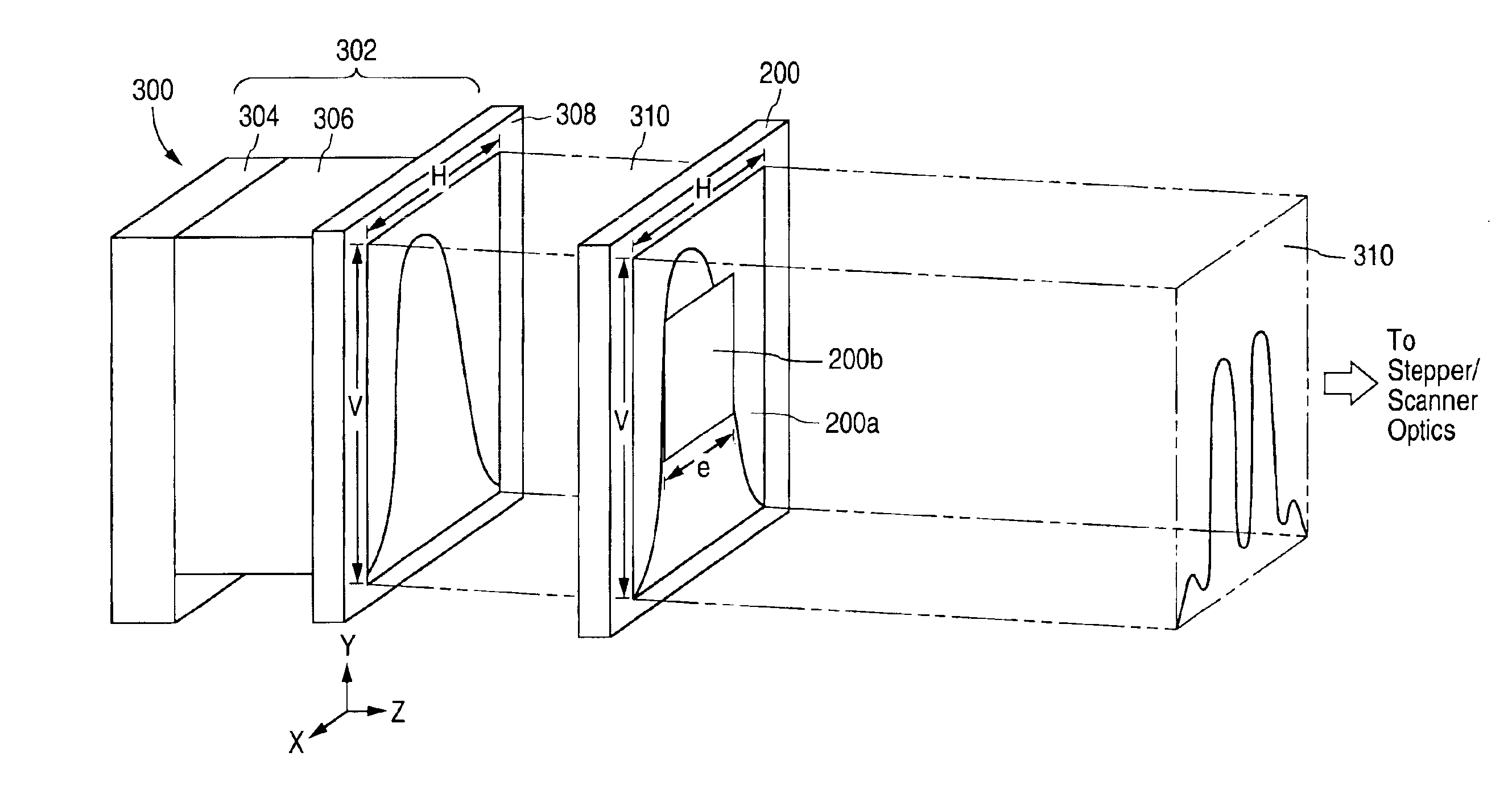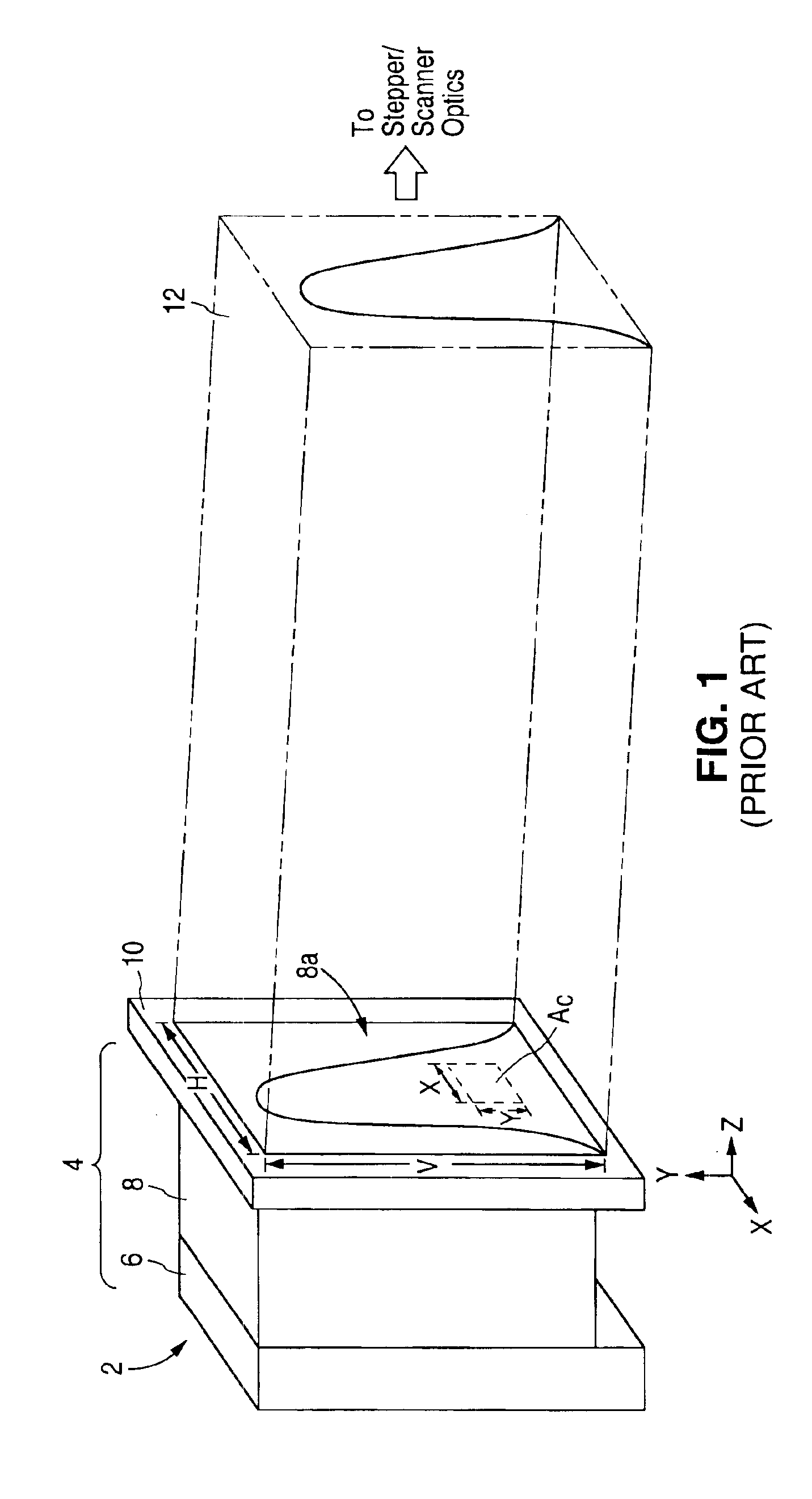Reduction of laser speckle in photolithography by controlled disruption of spatial coherence of laser beam
a laser beam and spatial coherence technology, applied in the field of apparatus and process for reducing speckle exhibited by laser beams, can solve the problems of high spatial coherence, difficult to achieve achromatic imaging optics in these wavelength regions, and problems relating to speckle, so as to reduce laser beam speckle laser beam speckle reduction
- Summary
- Abstract
- Description
- Claims
- Application Information
AI Technical Summary
Benefits of technology
Problems solved by technology
Method used
Image
Examples
first embodiment
[0064]FIG. 3a shows a laser employing an anti-speckle apparatus in accordance with the present invention. Laser 300 includes resonator 302 including narrow band unit 304, discharge tube 306, and outcoupling mirror 308. Preferred gas mixtures and methods of stabilizing gas mixtures of these excimer lasers and other lasers such as the XeF, XeCl, KrCl excimer lasers, as well as the molecular fluorine laser, are described at: U.S. Pat. Nos. 4,393,505, 4,977,573 and 5,396,514, and U.S. patent applications Ser. Nos. 09 / 317,526, 09 / 418,052, 09 / 513,025, 60 / 137,907, 09 / 379,034, 60 / 160,126 and 60 / 124,785, each of which is assigned to the same assignee as the present application.
[0065]Laser beam 310 of fixed pulse length exits discharge tube 306 through an aperture having width H and height V, and passes through outcoupling mirror 308. At the time of passing through outcoupling mirror 308, beam 310 exhibits a high degree of spatial coherence in the x-y plane.
[0066]However, laser 300 further in...
embodiment 305
[0069]FIG. 3d shows a fourth laser embodiment 305 employing an anti-speckle apparatus 201 as an output coupler. In this way, the antispeckle apparatus 201 also has the reflectivity of a typical output coupler of an excimer or molecular fluorine laser and transmits the output beam 310. The plate 201 may be two plates such as produce etalonning in the system, as well. The plate may serves to dispersively line-narrow, such as being formed to disperse the beam as a prism or transmission grating or grism would, in addition to reducing the speckle and / or output coupling the beam. The fly eye lens 320 is shown in FIG. 3d, but may be taken out, as desired.
[0070]FIGS. 4A-4D show the calculated far field intensity distribution along the x-axis only, of beam 310 after it has passed through a anti-speckle apparatus 200 of FIG. 2 exhibiting a fixed phase shift of π and having center region 200b of various widths eH. Beam intensities are shown for phase retarding apparatuses where e varies from e...
third embodiment
[0075]FIG. 6 shows an antispeckle apparatus in accordance with the present invention. Phase retarder plate 600 includes alternating regions 600a and 600b bearing different optical coatings that cause a relative shift in the phase of beam portions passing through these coated regions.
[0076]The embodiments of anti-speckle apparatuses described in conjunction with FIGS. 2, 5, and 6 are most advantageously used with a pulsed semi-narrow band excimer laser such as a KrF or ArF excimer laser having a characteristic bandwidth in excess of 200 pm, and an output beam narrowed to under 100 pm, typically using a dispersive prism. Other lasers such as the molecular fluorine laser could also benefit from the present invention.
[0077]In addition, these embodiments are most advantageously used in a photolithographic system including a catadioptric or all-reflective imaging system. Acceptable input laser emission bandwidths for catadioptric imaging systems are between about 15-100 pm at 248 nm, and ...
PUM
 Login to View More
Login to View More Abstract
Description
Claims
Application Information
 Login to View More
Login to View More - R&D
- Intellectual Property
- Life Sciences
- Materials
- Tech Scout
- Unparalleled Data Quality
- Higher Quality Content
- 60% Fewer Hallucinations
Browse by: Latest US Patents, China's latest patents, Technical Efficacy Thesaurus, Application Domain, Technology Topic, Popular Technical Reports.
© 2025 PatSnap. All rights reserved.Legal|Privacy policy|Modern Slavery Act Transparency Statement|Sitemap|About US| Contact US: help@patsnap.com



